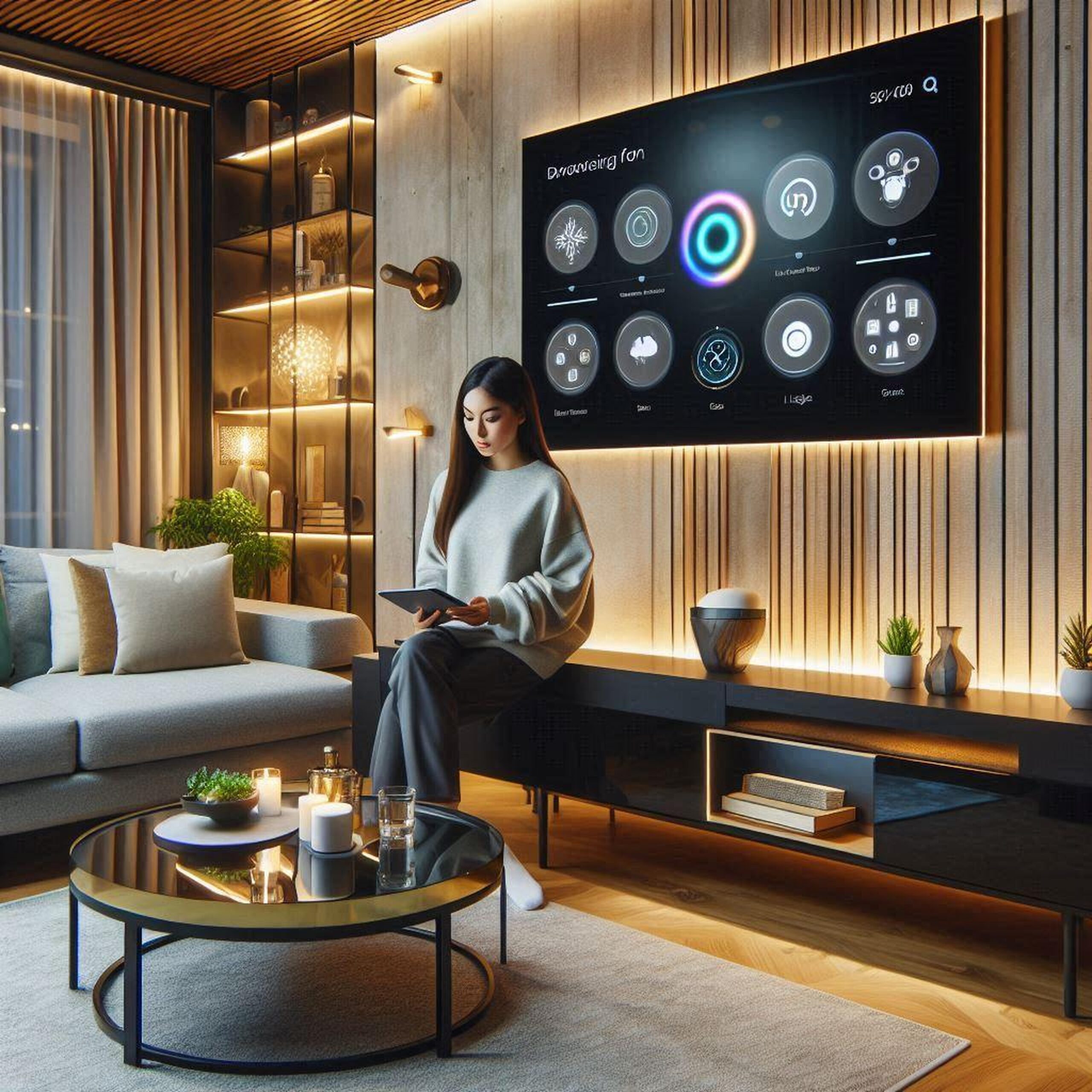This blog contains Amazon affiliate links. If you click on these links and make a purchase, We may earn a small commission at no extra cost to you. This helps support the site and allows us to continue providing helpful content. Thank you for your support!
Purchasing a new Smart TV is a significant decision that can greatly enhance your home entertainment experience. With the wide variety of options available today, from screen sizes and resolutions to operating systems and smart features, choosing the right Smart TV can be daunting. Whether you’re a casual viewer or a tech enthusiast, this guide will help you identify the most important factors to consider when buying a Smart TV for your home.
- Screen Size: Bigger Isn’t Always Better
One of the first considerations when buying a Smart TV is its screen size. While larger screens provide a more immersive experience, bigger isn’t always better, especially if your room isn’t large enough to accommodate it. To ensure you choose the right size, think about the viewing distance from your sofa to the TV. A general rule is that the ideal screen size is based on sitting at a distance that is 1.5 to 2.5 times the diagonal size of the TV.
For example:
- For a 55-inch TV, the optimal viewing distance would be between 2.1 to 3.5 metres.
- For a 65-inch TV, the distance should be between 2.4 to 4 metres.
If you have a smaller living room or bedroom, a 32 to 50-inch TV might be more suitable. Conversely, for a large living room, consider sizes starting at 55 inches or above.
- Resolution: 4K vs. 8K
Resolution refers to the number of pixels in the picture on your TV, and higher resolution means better picture quality. Today, most Smart TVs come with 4K resolution, four times the Full HD resolution. This is more than sufficient for most viewing experiences, and the majority of content on platforms like Netflix and Amazon Prime Video supports 4K HDR.
However, 8K TVs are also available, offering four times the resolution of 4K. While 8K may seem appealing, its content is still limited. Unless you’re an early adopter who wants to future-proof your home setup, 4K remains the more practical and affordable option for now.
Key Takeaway:
- 4K TVs are the current standard and offer excellent picture quality.
- 8K TVs are cutting-edge, but content is limited, making them less essential for most viewers.
- Display Technology: LED, OLED, or QLED?
Choosing the right display technology is essential for determining the picture quality and performance of your Smart TV. There are three main options to consider:
- LED (Light-Emitting Diode): Most affordable Smart TVs use LED technology. They provide bright images, which are ideal for rooms with lots of natural light, but may lack the deep blacks and high contrast of OLED TVs.
- OLED (Organic Light-Emitting Diode): OLED TVs offer superior picture quality, with deeper blacks and better contrast. Since each pixel emits its own light, these TVs provide more accurate colours and sharper details, especially in darker scenes. However, OLED TVs tend to be more expensive.
- QLED (Quantum Dot LED): QLED TVs, a technology developed by Samsung, improve upon LED by incorporating quantum dots to enhance brightness and colour accuracy. QLED TVs are a great option for brighter rooms but may still not match OLED in terms of contrast and black levels.
Key Takeaway:
- OLED TVs offer the best picture quality, especially for movie lovers.
- QLED TVs are excellent for bright rooms, offering vibrant colours and improved brightness.
- LED TVs are more affordable but may provide a different level of performance than OLED or QLED.
- Smart TV Operating Systems
The operating system (OS) that powers your Smart TV can impact the user experience. Popular operating systems include:
- Android TV: Android TV offers a flexible platform with access to the Google Play Store for apps and games. It integrates well with Google Assistant and supports voice commands. Sony and TCL are some of the brands using Android TV.
- Tizen (Samsung): Samsung’s Tizen OS is known for its intuitive interface and smooth performance. It comes pre-installed with apps like Netflix, YouTube, and Disney+, and supports voice assistants like Bixby and Alexa.
- webOS (LG): LG’s webOS offers a simple, user-friendly interface with a ribbon-style menu that makes it easy to navigate through apps. Google Assistant and Alexa are integrated for voice commands.
- Roku TV: Roku is widely known for its simple, no-frills interface. It offers easy access to major streaming services, and the platform is often found in budget-friendly TVs.
Key Takeaway:
- If you prefer Google integration and flexibility, go for an Android TV.
- For smooth performance and a user-friendly interface, consider Tizen or webOS.
- Roku TV is ideal for users seeking simplicity and affordability.
- High Dynamic Range (HDR)
HDR (High Dynamic Range) enhances a TV’s contrast and colour range, allowing for brighter highlights and deeper shadows. If you’re a fan of visually stunning content, such as action films or nature documentaries, choosing a Smart TV that supports HDR is essential. There are different HDR formats, including:
- HDR10: The most common format, supported by most Smart TVs and streaming platforms.
- Dolby Vision: A premium format that offers even better colour accuracy and dynamic range, but is supported by fewer models.
If you want the best visual experience, look for TVs that support Dolby Vision, but even HDR10 can make a noticeable difference in picture quality.
Key Takeaway:
- HDR10 provides a good improvement in picture quality.
- Dolby Vision offers an even more immersive viewing experience but is found on higher-end models.
- Refresh Rate: 60Hz vs. 120Hz
The refresh rate refers to how many times the picture refreshes per second. Most TVs have a refresh rate of 60Hz, which is adequate for watching most TV shows and films. However, if you’re a gamer or watch a lot of fast-paced sports, you may want to consider a 120Hz TV. The higher refresh rate results in smoother motion and less blurring during fast-moving scenes.
Key Takeaway:
- 60Hz is suitable for most casual viewers.
- 120Hz is ideal for gamers and sports fans, offering a smoother experience.
- Connectivity and Ports
Smart TVs serve as a hub for all your entertainment devices, from gaming consoles to sound systems. Make sure the TV you choose has enough HDMI ports for all your devices. HDMI 2.1 is the latest version and supports 4K 120Hz content, which is particularly important for gamers with next-gen consoles like the PlayStation 5 and Xbox Series X.
Also, check for USB ports to connect external hard drives or other peripherals. Built-in Wi-Fi and Ethernet connections ensure smooth streaming, especially for 4K content.
Key Takeaway:
- If you plan to connect gaming consoles or other high-end devices, ensure your TV has multiple HDMI ports and supports HDMI 2.1.
- Wi-Fi and Ethernet are essential for streaming content smoothly.
Conclusion
Choosing the suitable Smart TV for your home depends on a balance of factors including screen size, resolution, display technology, and features like HDR and refresh rate. While OLED provides the best picture quality, LED and QLED models are great alternatives for brighter rooms or budget-conscious buyers. The operating system and smart features also play a crucial role in the overall user experience.
By considering your room size, viewing habits, and budget, you can find a Smart TV that perfectly fits your home entertainment needs. Whether you’re watching your favourite shows on Netflix, gaming with the latest console, or enjoying a cinematic film night, choosing the right Smart TV will elevate your viewing experience.



Comments are closed